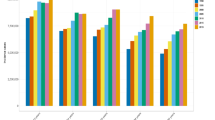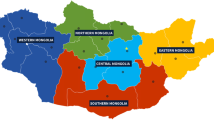Abstract
Earlier studies have raised the issue that Asians have a much lower migraine prevalence than Westerners. This article reviews the recent epidemiologic studies of headache in Asia using International Headache Society (IHS) classification criteria. Except for the Korean study and the first Hong Kong study (1992 to 1993), the prevalence of migraine has been quite consistent, ranging from 8.4% to 12.7%. The sex-specific migraine prevalence was 11.3% to 14.4% in women and 3.6% to 6.7% in men. The prevalence of IHS tension-type headache has also been similar among these studies (15.6% to 25.7%). The consistency of the prevalence of migraine and tension-type headache among these Asian countries is interesting in a region where the cultural background and development are so diverse. These IHS migraine surveys show that migraine is a significant disease in Asia and that its prevalence rate is close to but in the low range of the those reported in Western countries. Two surveys of chronic daily headache conducted in Taiwan, one in the general population and the other in the elderly population, have also revealed prevalence rates (3.2% to 3.9%) similar to those of Western countries (3.0% to 4.7%). The geographic or ethnic diversity of migraine or other types of headache could be downplayed if a similar epidemiologic methodology and an identical case definition were used in the surveys among different regions of the world.
Similar content being viewed by others
References and Recommended Reading
Stewart WF, Lipton RB, Liberman J: Variation in migraine prevalence by race. Neurology 1996, 47:52–59.
Cheng XM, Cai K, Li SC, et al.: An epidemiologic survey of migraine in six cities in China. Chin J Neurol 1990, 23:44–46.
Zhao F, Tsay JY, Cheng XM, et al.: Epidemiology of migraine: a survey in 21 provinces of the People’s Republic of China, 1985. Headache 1988, 28:558–565.
Stewart WF, Simon D, Shechter A, Lipton RB: Population variation in migraine prevalence: a meta-analysis. J Clin Epidemiol 1995, 48:269–280.
Wong TW, Wonag KS, Yu TS, Kay R: Prevalence of migraine and other headaches in Hong Kong. Neuroepidemiology 1995, 14:82–91.
Headache Classification Committee of the International Headache Society. Classification and diagnosis criteria for headache disorders, cranial neuralgias and facial pains. Cephalalgia 1988, 8(suppl 7):1–96.
Silberstein SD, Lipton RB: Epidemiology of migraine. Neuroepidemiology 1993, 12:179–194.
Solomon S, Lipton RB, Newman LC: Clinical features of chronic daily headache. Headache 1992, 32:325–329.
Mathew NT, Reuveni U, Perez F: Transformed or evolutive migraine. Headache 1987, 27:102–106.
Wang SJ, Fuh JL, Lu SR, Juang KD: Quality of life differs among headache diagnoses: analysis of SF-36 survey in 901 headache patients. Pain 2001, 89:285–292.
Silberstein SD, Lipton RB, Sliwinski M: Classification of daily and near-daily headaches: field trial of revised IHS criteria. Neurology 1996, 47:871–875.
Alders EE, Hentzen A, Yan CT: A community-based prevalence study on headache in Malaysia. Headache 1996, 36:379–384.
Sakai F, Igarashi H: Prevalence of migraine in Japan: a nationwide survey. Cephalalgia 1997, 17:15–22.
Roh JK, Kim JS, Ahn YO: Epidemiological and clinical characteristics of migraine and tension-type headache in Korea. Headache 1988, 38:356–365.
CheungRT: Prevalence of migraine, tension-type headache, and other headaches in Hong Kong. Headache 2000, 40:473–479. The second population-based migraine survey in Hong Kong.
Wang SJ, Fuh JL, Young YH, et al.: Prevalence of migraine in Taipei, Taiwan: a population-based survey. Cephalalgia 2000, 20:566–572. The first population-based International Headache Society migraine survey in Taipei, Taiwan. The diagnostic criteria of migraine were modified by change of the duration of headache from 2 to 72 hours.
Lu SR, Fuh JL, Chen WT, et al.: Chronic daily headache in Taipei, Taiwan: prevalence, follow-up and outcome predictors. Cephalalgia 2001, 21:980–986. A comprehensive, community-based survey and follow-up of chronic daily headache in Taipei, Taiwan, including prevalence, risk factors, follow-up, outcome predictors, and medication overuse.
Wang SJ, Fuh JL, Lu SR, et al.: Chronic daily headache in Chinese elderly: prevalence, risk factors, and biannual follow-up. Neurology 2000, 54:314–319. The first community-based survey of chronic daily headache in the elderly.
WatersWE: The Pontypridd headache survey. Headache 1974, 14:81–90.
Henry P, Auray JP, Gaudin AF, et al.: Prevalence and clinical characteristics of migraine in France. Neurology 2002, 59:232–237.
Rasmussen BK, Jensen R, Schroll M, Olesen J: Epidemiology of headache in a general population—a prevalence study. J Clin Epidemiol 1991, 44:1147–1157.
Stewart WF, Lipton RB, Celentano DD, Reed ML: Prevalence of migraine headache in the United States: relation to age, income, race and other sociodemographic factors. JAMA 1992, 267:64–69.
Launer LJ, Terwindt GM, Ferrari MD: The prevalence and characteristics of migraine in a population-based cohort: the GEM Study. Neurology 1999, 53:537–542.
Rasmussen BK, Olesen J: Migraine with aura and migraine without aura: an epidemiological study. Cephalalgia 1992, 12:221–228.
Lipton RB, Stewart WF, Diamond S, et al.: Prevalence and burden of migraine in the United States: data from the American Migraine Study II. Headache 2001, 41:646–657.
Henry P, Michel P, Brochet B, et al.: GRIM: A nationwide survey of migraine in France: prevalence and clinical features in adults. Cephalalgia 1992, 12:229–237.
Scher AI, Stewart WF, Liberman J, Lipton RB: Prevalence of frequent headache in a population sample. Headache 1998, 38:497–506.
Castillo J, Muñoz P, Guitera V, Pascual J: Epidemiology of chronic daily headache in the general population. Headache 1999, 39:190–196.
Prencipe M, Casini AR, Ferretti C, et al.: Prevalence of headache in an elderly population: attack frequency, disability, and use of medication. J Neurol Neurosurg Psychiatry 2001, 70:377–381.
Silberstein SD, Schulman EA, Hopkins MM: Repetitive intravenous DHE in the treatment of refractory headache. Headache 1990, 30:334–339.
Author information
Authors and Affiliations
Rights and permissions
About this article
Cite this article
Wang, SJ. Epidemiology of migraine and other types of headache in Asia. Curr Neurol Neurosci Rep 3, 104–108 (2003). https://doi.org/10.1007/s11910-003-0060-7
Issue Date:
DOI: https://doi.org/10.1007/s11910-003-0060-7




